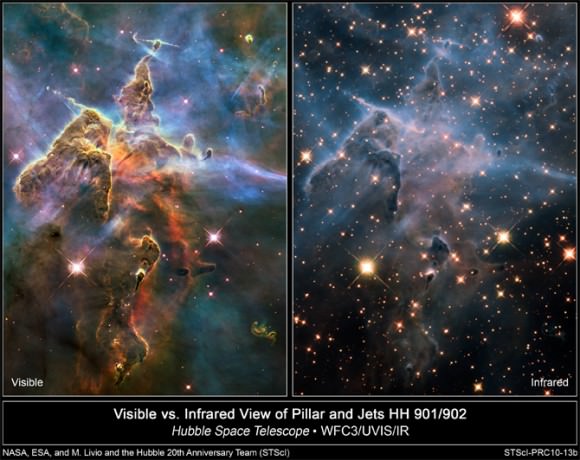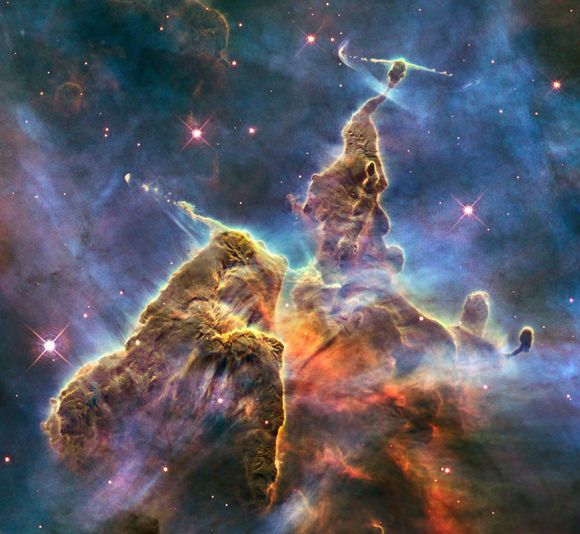[/caption]
Happy 20th Birthday to the Hubble Space Telescope! While we should be showering HST with gifts, instead the telescope provides this present to us: an amazing view of what has been nicknamed “Mystic Mountain. ” It is just a small portion of one of the largest known star-birth regions in the galaxy, the Carina Nebula. Three light-year-tall towers of cool hydrogen laced with dust rise from the wall of the nebula. The scene is reminiscent of Hubble’s classic “Pillars of Creation” photo from 1995, but even more striking. “Mystic Mountain has clouds of gas and dust, that have not only baby stars, but also baby solar systems,” said John Grunsfeld, Hubble-hugger, repairman and now the Deputry Director of the Space Telescope Science Institute. “4.5 billion years ago, this may be what our solar system looked like.”
Would you like to wish Hubble a happy birthday?
Hubble fans worldwide are being invited to take an interactive journey with Hubble. They can also visit Hubble Site to share the ways the telescope has affected them. Follow the “Messages to Hubble” link to send an e-mail, post a Facebook message, or send a cell phone text message. Fan messages will be stored in the Hubble data archive along with the telescope’s science data. For those who use Twitter, you can follow @HubbleTelescope or post tweets using the Twitter hashtag #hst20.

Hubble launched on April 24, 1990.
“Hubble is undoubtedly one of the most recognized and successful scientific projects in history,” said Ed Weiler, associate administrator for the Science Mission Directorate at NASA Headquarters in Washington. “Last year’s space shuttle servicing mission left the observatory operating at peak capacity, giving it a new beginning for scientific achievements that impact our society.”
This morning during interviews on NASA TV, Grunsfeld and Weiler said they both felt fortunate to work with Hubble, a telescope who’s legacy will live on, no matter how much longer the telescope operates.
“I’m lucky to have worked on a project that will outlive me,” Weiler said.
“The discovery that I think is so incredible, and could not be imaged was that Hubble has now analyzed the constituents of an atmosphere of a planet around another star,” said Grunsfeld. “It is as if we were exploring that planet – and that’s what Hubble does for us, allows us to visit places we’ll never be able to go.”
On that note, take a 3-D trip into the Carina Nebula with the video below:


Looking at these images remind you just how small and insignificant we humans are in this universe. Not to mention the unique history which gave birth to us.
At only 7500 light years away, it does make you wonder how our little area of the galaxy looked 5 billion years ago.
Can’t thank the Hubble team enough for their work.
Wow – just WOW! Take a look at the shock front around the end of that Herbig-Haro jet up the top!! Beautiful.
What a damn fine image.
Beautiful images and an excellent series of articles.
BTW. “a telescope who’s legacy will live on” – ‘who’s’ = who is. Try ‘whose’ instead….
The Hubble site has an excellent montage of this area with scale information for these images here: http://imgsrc.hubblesite.org/hu/db/images/hs-2010-13-i-print.jpg
For instance, the bipolar jet of HH 901/902 in the top portion of the image measures about 0.61 light-years in length. This annotated image help one to get a better perspective on the scale of the object(s) portrayed.
The side-by-side image reminds me just how much we will lose at the end of Hubble’s mission – being that there is no visible-wavelength replacement planned anytime soon (until or even if the ATLAST gets built and launched a couple of decades from now).
Outstanding image!
@bigstevie
The ground-based observatories are by now at least equal to Hubble, and with the new E-ELT of ESO the optical part is well covered.
There is just no need anymore for optical ‘scopes in space thanks to adaptive optics.
DrFlimmer,
There are quite a few things the Hubble, with its current instruments, can do that ground-based facilities can’t today (and some, will never be able to do).
Here are a few, off the top of my head:
* observations in the UV (the Earth’s atmosphere is completely opaque below ~300nm)
* high resolution so-called wide field observations: the ACS’s Wide Field Channel gives 202″ x 202″ with 0.05″ per pixel, from 350nm to 1000nm (I’m not sure what the capabilities of ground-based facilities are, or will be, but the ACS would be very hard to beat, especially the wide wavelength coverage)
* NIR observations (ground-based facilities are limited by the various atmospheric molecular bands)
* high duty cycle/availability (the Hubble can work 24×7; ground-facilities in the optical are limited to night, and mostly to moonless night at that)